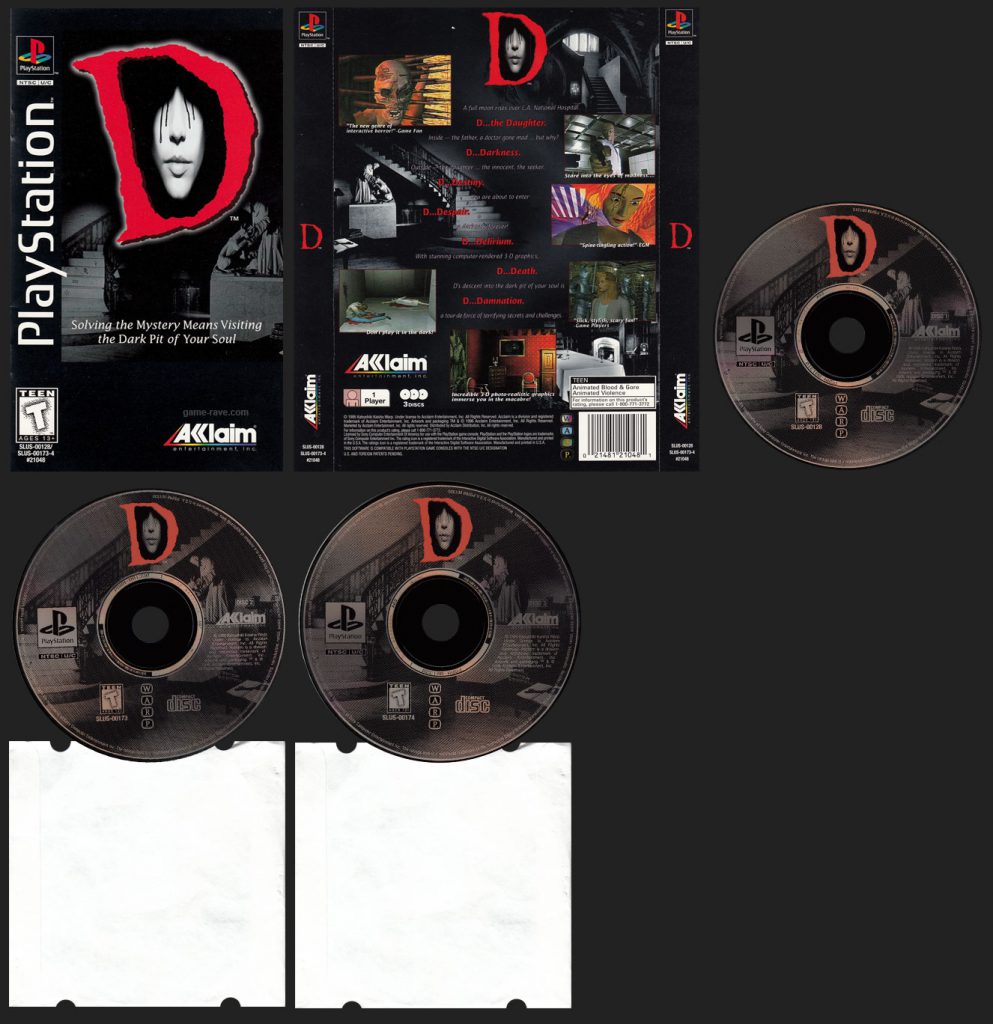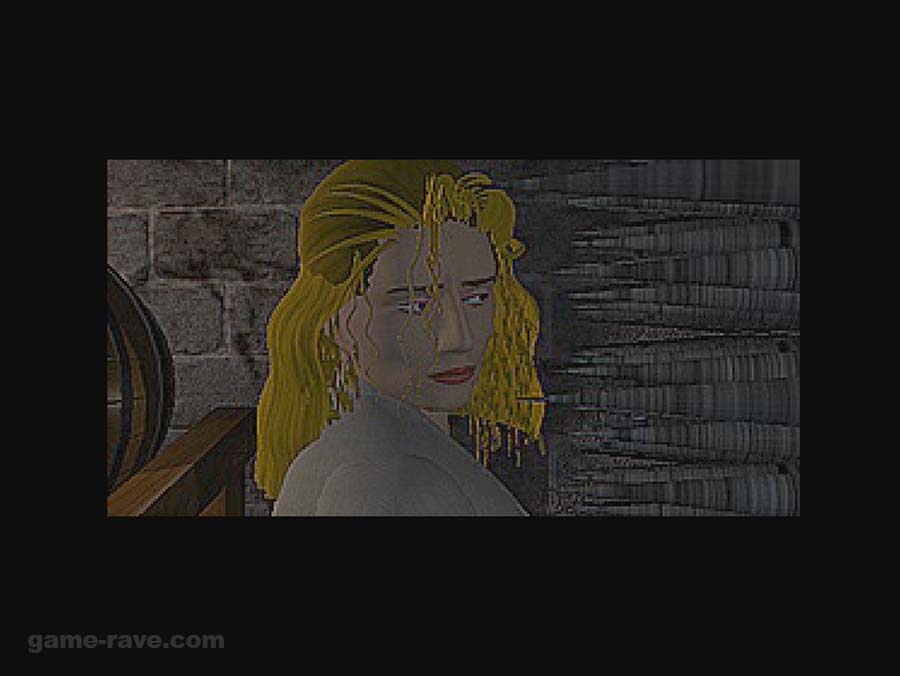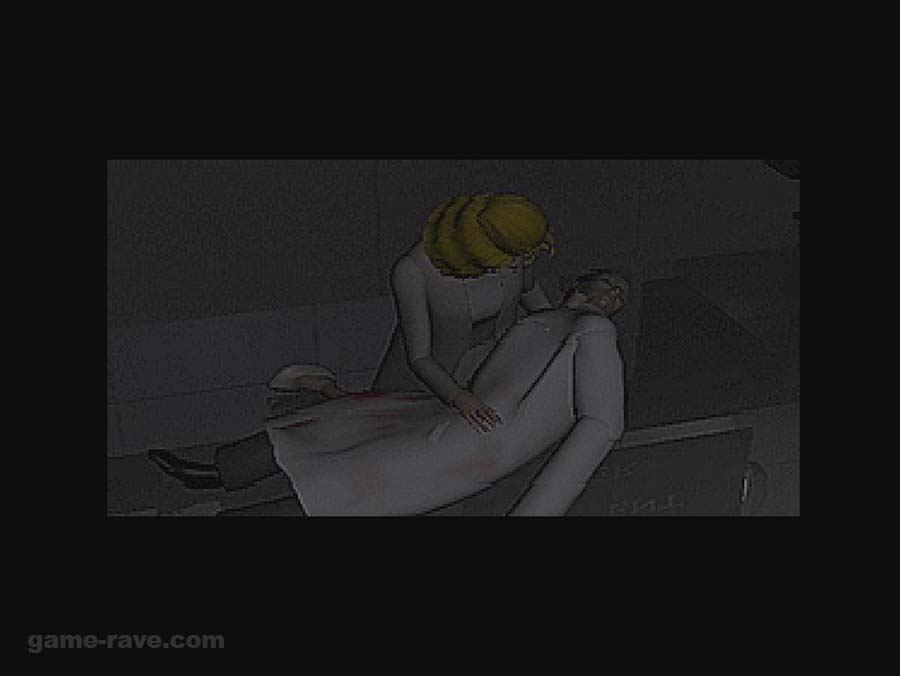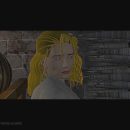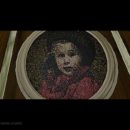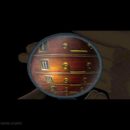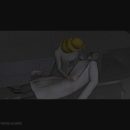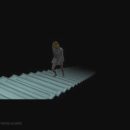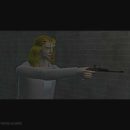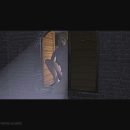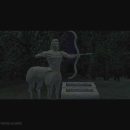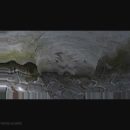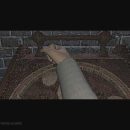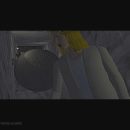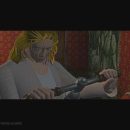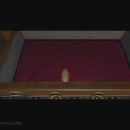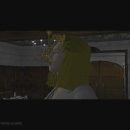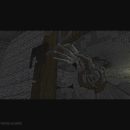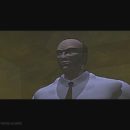| Genre: Full Motion Video |
CDs: 3 |
|---|---|
| Publisher: Acclaim |
Released: March 2, 1996 |
| Developer: WARP |
UPC: 0 21481 21048 1 |
| Sony ID: SLUS-00128, 00173, 00174 |
PSRM: 001310, 001330, 001320 |
| Players: 1 Player |
Memory: None |
| Accessories: None |
|
| ESRB: Teen – Animated Blood & Gore, Animated Violence |
|
| Box Copy:
A full moon rises over L.A. National Hospital. Inside – the father, a doctor gone mad…but why? Outside – the daughter…the innocent, the seeker. You are about to enter the darkness forever! With stunning computer-rendered 3-D graphics, D’s descent into the dark pit of your soul is a tour de force of terrifying secrets and challenges. |
|
Variants
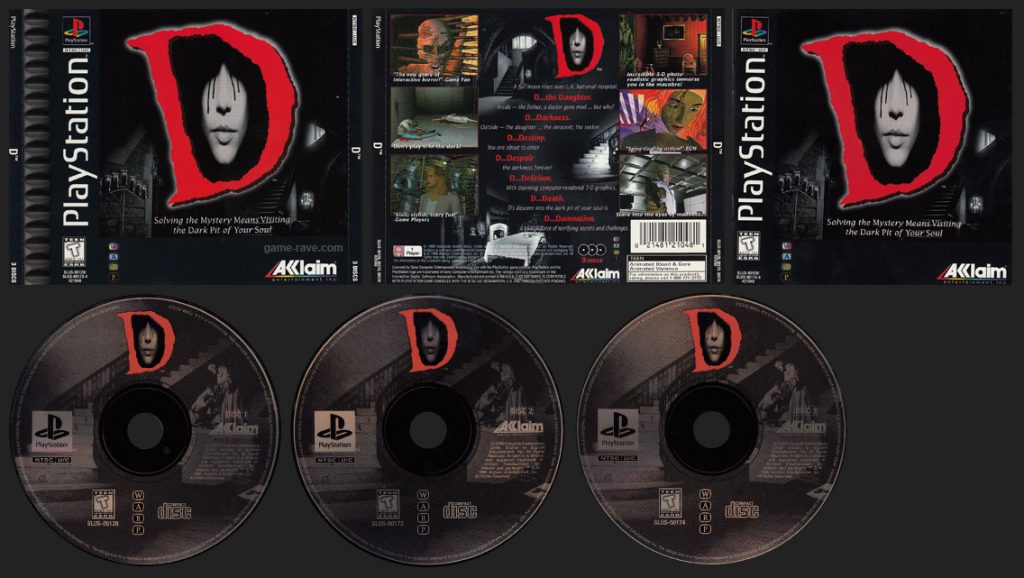
Double Jewel Case Release – The discs are different from the long box – they don’t have the large outer silver ring on the hubs.
Misprints
- There are no known misprints.
Review
The PlayStation is home to many games, but none may have a stranger history than that of D. From the creative mind of the now-late Kenji Eno, D places gamers in control of Laura. The daughter of a famous doctor named Richter who has gone off the deep end by killing visitors and taking hostages at his hospital. Laura races to the scene from her college 3 hours away, and as she enters the crime scene, so begins the story of D.
As Laura enters the hospital a weird vertical water blob whisks her away to a dimly lit and cold castle-like environment. With the front door locked behind her, our hero’s only choice is to wander the building trying to find her father and the way home. Players will start in a dining room with a staircase on the far left, but something more ominous is in play.
D must be finished in 2 hours or you lose, and there is no pausing allowed. You are essentially twice trapped; once within Laura’s life and second within the real-world time limit. This is actually tracked in-menu via Laura’s pocket watch. The story starts at 3 pm and you have till 5 pm to find your father – the clock moves in real time as you watch it.
Besides the timepiece, Laura also has her compact, which acts as a tip provider. If used, she’ll open it up and the mirror will reveal where you should head to next. The catch is that the mirror will crack after each hint and there are only 3 cracks allowed.
So there are 2 hours to kill and all we need to do is find Pops? Cool, let’s just run…or not. For horror and survival games to click, they need to have something stripped from them – in this case, a proper control scheme. Like Resident Evil’s “tank controls”, D is played entirely from film clips. If Laura is to walk forward, players see pre-rendered, 1st-person footage of her walking forward. Once she’s able to interact with something or get called on by her father, the camera shifts to a 3rd-person view of her trials.
This cost-of-movement plays directly into the timed adventure; every move one makes requires a set amount of time, which forces the player to think about the next step. Thankfully Warp spares gamers the threat of an early death; the only way Laura can die is by running out of time. Even then she doesn’t really die – she’s simply trapped in castle-land.
The bigger issue comes literally into play with the footage. Because players are trapped by the moving clips, Warp had to make some some fairly mind-breaking decisions on how to lay the tracks on which the user moves. For example: in the first room you can move to the left or right of the table as you would do in real life. In a later room, there is a diagonal path that connects parts of the room, and trying to find which “track” is the right one can delay and confuse you. A much darker design choice lay in wait near the end of the game.
Once players arrive at the third disc, there is a rotating room whose only purpose is to slow them down. Here’s how it works. The puzzles here are connected to each room in sequential order; you take item A from room A, use it in Room B to get item B, and so on. Except Warp added extra fake choices to the spinner. Instead of having to track 5 turns, there’s now 11 results – and if someone loses count and overshoots their destination, they have to circle back that many more turns. It’s not a deal breaker, but it destroys the flow of the game.
With Full Motion Video Games, the footage provided needs to be top-of-the-line to keep the audience interested. Despite looking dated by today’s standards, D was gorgeous for it’s time-frame. Laura’s bizarre hair modeling aside, the castle’s creepiness factor is illustrated perfectly. Stone hallways turn into spike-filled walls; furniture is vintage, clearly abandoned for years. Little touches with early jump scares and disturbing revelations help sell the hopelessness, but we’ll get back to that in a second.
Surprisingly, D’s finest angle is when it’s at its most subtle – specifically in the music department. Moments of interest have triumphant musical cues, and item acquirement has a comforting little melody. But it’s when the user is simply exploring the castle that the audio shines. It’s not really music – it’s more moody white noise. Slow, simple droning audio clips play on a loop until you find something of interest. If you’ve never played D before, use headphones and play in the dark. It really does help pull the player in.
Before closing out this review, there are two interesting details to the game. First – in order to get the true 100% ending the player must successfully find 4 scarab beetles hidden throughout the game. There are two possible beetles per disc, with the 4th and final beetle hidden in the final passageway. These beetles present the first of creator Kenji Eno’s two devious actions. According to several guides across all three platforms (PlayStation, 3DO, Saturn), their appearances are random; they may appear or they may not appear at all. Sometimes the way the castle is searched may trigger them. This randomness means completionists like myself may not get 100% on your first run…or second run….and so on.
Secondly and most importantly is how far Kenji Eno was willing to go to see his game released. In an interview, the developer revealed he pulled a bait-and-switch with the game’s most violent content. Afraid that Sony would censor or block the release of the game, Eno found and exploited a loophole in Sony’s submission requirements. If a publisher submitted their masters too late, they would pay a fine and then need to hand deliver the masters in person.
Knowing this, Eno submitted ‘clean’ masters of the game late, and then later while on the plane to deliver the approved masters, swapped the clean version discs with the real version of the game. This assured that all the disturbing images – including an act of murder and cannibalism – would make it to the consumers’ consoles. In a modern world this would probably have ended his career, but with the game selling over a million copies in Japan alone, any retaliation was quietly wiped under the rug. He and Sony would continue to have a strained relationship, but that’s for another time.
More than two-decades after its release D finds itself in a unique position for historians and ‘librarians’ like me. It’s still well-worth a once-through and even speed-runners can challenge themselves against the randomness of the beetle appearances. Having played through it at least 6 or more times in the last 10 years, there’s still that charm of spookiness to it that can’t be shaken.
The Good
- Truly fascinating use of FMV and time-driven gameplay
- Simple controls allow the focus to be on the puzzles
- Breathtaking graphics for its time
The Bad
- Two specific puzzles derail the flow
- No save or pause options
- Hidden items can be hidden
Final Score: 7 / 10 – Solid
D is the video game equivalent of an old vinyl record. Sure you could enjoy a 4K Resolution, high-end video game experience; but sometimes you need that static and dated sound to fully appreciate the material contained within.
Screenshots
Videos
Review for the Game on GameRaveTV,

Trivia
- There are 4 possible endings to the game. See the Secrets tab.
- D’s disc PSRM numbers are out of whack. Disc 2 comes AFTER Disc 3’s when they should both be sequential. This is more than likely due to WARP not realizing they would need a 3rd disc, considering the other versions are only having 2. Instead of breaking the game up at the end, they broke it up in the middle.
- Sony’s version comes on 3 Discs. All other versions come on 2.
- The shortest title word / letter-wise in the PlayStation and Saturn library – with Z in the import market tying it for first.
- Also one of the shortest – the game, no matter what, ends at the 2-hour mark, with no pause option. You either succeed, or you don’t.
- While it is trying to represent the house/home you wander around, most of the cover and back insert images of various real-life rooms look nothing like the in-game setup.
- Laura, the in-game protagonist, actually starred in other games, including D2 and Enemy Zero. Warp treated her like a virtual actress.
- Laura never utters a word in the entire 2-hour experience.
- While not important to the story, it is never explained where the cops in the opening cinematic go, or how they would have allowed Laura into the crime scene with so much chaos going on. It’s also interesting to note that aside from her father, everyone else Laura comes across in the actual game is dead. Adds a nice layer of creepiness to the experience.
- In the 3DO version, the traveling between dimensions is handled differently. In the 3DO, when Laura first covers her eyes in the hospital, she is instantly transported. In the PSX and Saturn versions, she discovers a bubbly wormhole-like entity that absorbs her.
- Laura’s father is named Richter, an interesting and unknown if intentional nod to the Castlevania protagonist.
- Several hint sections of the game – once solved on the first run, can be skipped entirely in future play-throughs because the puzzle solutions never change.
- You can watch the pocket watch in Laura’s inventory in real time. It will only stop once you reach the final screen of the game.
- Laura retains every item she picks up in the game. It’s safe to assume this was intentional by the designers as it ticks off seconds from the timer as you scroll through your inventory.
- There is a discrepancy in the game based on the opening cinema. The hospital’s clock reads 2 o’clock, but Laura is 6 hours away. Her in-game pocket watch says it’s 3 pm when you start. It should be at a minimum 8pm.
- Spoiler: You will need to know the symbols that represent Astrology signs to solve one of the hints.
- Spoiler: In the Japanese Director’s Cut called D’s Diner, players were treated to a hidden video at the end that revealed the original version of the sequel D2. It would have focused on Laura’s son. It was quietly canceled with the cancellation of the M2 system.
Secrets
D has some interesting twists in the tale it wants to tell.
- 4 Possible Endings (Spoiler Free)
Worst Ending: Time runs out.
Bad Ending: You press Up on the final screen.
Good Ending: You use a specific item on the final screen, but do not have all 4 Scarab Beetles.
Best Ending: You use a specific item on the final screen, and have all 4 Scarab Beetles. - Scarab Beetle Locations
To secure the best ending, players will need to find 4 Scarab Beetles that trigger flashbacks. The problem is that currently the locations of the beetles are confirmed, but how to trigger them is unknown. According to multiple sources, the beetles are completely random, including possibly not even showing up. This is currently on Project Up1’s itinerary to verify. In the meantime, each disc has 1 Scarab Beetle that can show up in one of two spots. If the player finds it in one spot, it will not show in the other.- Disc 1
a. Upon starting the game, turn 180 degrees and check the front door.
b. In the top drawer of the numbered chest of drawers on the second floor. - Disc 2
a. Bookshelf where the book goes.
b. On the desk where the book is stored. - Disc 3
a. In the Spinning Room with the handle. Spin 12 times and then investigate the original gate.
b. Walking towards the outside fountain from the stairwell. - Disc 3 – Final Scarab
In the long hallway after you climb into the tower, walk to the opposite wall and investigate the wall. A Beetle doesn’t seem to appear on screen, but this is the 4th and final one.
- Disc 1






